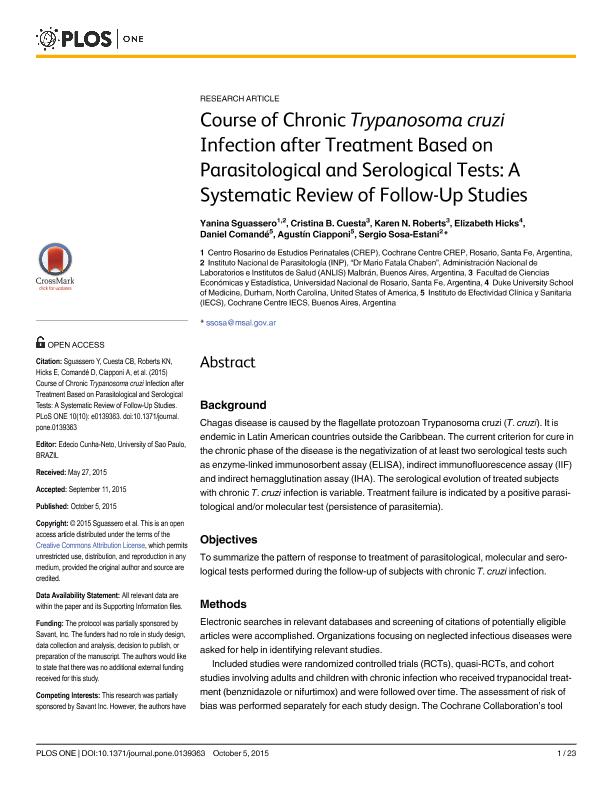Artículo
Course of Chronic Trypanosoma cruzi Infection after Treatment Based on Parasitological and Serological Tests: A Systematic Review of Follow-Up Studies
Sguassero, Yanina; Cuesta, Cristina B.; Roberts, Karen N.; Hicks, Elizabeth; Comandé, Daniel; Ciapponi, Agustín ; Sosa-Estani, Sergio Alejandro
; Sosa-Estani, Sergio Alejandro
 ; Sosa-Estani, Sergio Alejandro
; Sosa-Estani, Sergio Alejandro
Fecha de publicación:
10/2015
Editorial:
Public Library of Science
Revista:
Plos One
ISSN:
1932-6203
Idioma:
Inglés
Tipo de recurso:
Artículo publicado
Clasificación temática:
Resumen
Background: Chagas disease is caused by the flagellate protozoan Trypanosoma cruzi (T. cruzi). It is endemic in Latin American countries outside the Caribbean. The current criterion for cure in the chronic phase of the disease is the negativization of at least two serological tests such as enzyme-linked immunosorbent assay (ELISA), indirect immunofluorescence assay (IIF) and indirect hemagglutination assay (IHA). The serological evolution of treated subjects with chronic T. cruzi infection is variable. Treatment failure is indicated by a positive parasitological and/or molecular test (persistence of parasitemia). Objectives: To summarize the pattern of response to treatment of parasitological, molecular and serological tests performed during the follow-up of subjects with chronic T. cruzi infection. Methods: Electronic searches in relevant databases and screening of citations of potentially eligible articles were accomplished. Organizations focusing on neglected infectious diseases were asked for help in identifying relevant studies. Included studies were randomized controlled trials (RCTs), quasi-RCTs, and cohort studies involving adults and children with chronic infection who received trypanocidal treatment (benznidazole or nifurtimox) and were followed over time. The assessment of risk of bias was performed separately for each study design. The Cochrane Collaboration’s tool and the guidelines developed by Hayden et al. were used. Two reviewers extracted all data independently. A third review author was consulted in case of discordant opinion. Additional analyses were defined in ad-hoc basis. Scatter plots for percentage of positive parasitological and molecular tests and for negative serological tests were developed by using the lowess curve technique. Heterogeneity was measured by I2. The protocol was registered in PROSPERO, an international prospective register of systematic review protocols (Registration Number CRD42012002162). Results: Out of 2,136 citations screened, 54 studies (six RCTs and 48 cohort studies) were included. The smoothed curves for positive xenodiagnosis and positive polymerase chain reaction (PCR) were characterized by a sharp decrease at twelve month posttreatment. Afterwards, they reached 10–20% and 40% for xenodiagnosis and PCR, respectively. The smoothed curves for negative conventional serological tests increased up to 10% after 48 months of treatment. In the long-term, the rate of negativization was between 20% and 45%. The main sources of bias identified across cohort studies were the lack of control for confounding and attrition bias. In general, RCTs were judged as low risk of bias in all domains. The level of heterogeneity across included studies was moderate to high. Additional analysis were incomplete because of the limited availability of data. In this regard, the country of origin of study participants might affect the results of parasitological and molecular tests, while the level of risk of bias might affect serological outcomes. Subgroup analysis suggested that seronegativization occurs earlier in children compared to adults. Conclusions: We acknowledge that there is a dynamic pattern of response based on parasitological, molecular and serological tests in subjects chronically infected with T. cruzi after treatment. Our findings suggest a trypanocidal effect in the long-term follow-up. Further research is needed to explore potential sources of heterogeneity and to conduct reliable subgroup analysis.
Palabras clave:
Chagas
,
Trypanosoma Cruzi
,
Treatment
,
Systematic Review
Archivos asociados
Licencia
Identificadores
Colecciones
Articulos(SEDE CENTRAL)
Articulos de SEDE CENTRAL
Articulos de SEDE CENTRAL
Citación
Sguassero, Yanina; Cuesta, Cristina B.; Roberts, Karen N.; Hicks, Elizabeth; Comandé, Daniel; et al.; Course of Chronic Trypanosoma cruzi Infection after Treatment Based on Parasitological and Serological Tests: A Systematic Review of Follow-Up Studies; Public Library of Science; Plos One; 10; 10; 10-2015; 1-23; e0139363
Compartir
Altmétricas



